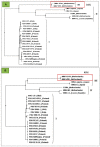Molecular Biology of Prune Dwarf Virus-A Lesser Known Member of the Bromoviridae but a Vital Component in the Dynamic Virus-Host Cell Interaction Network
- PMID: 29258199
- PMCID: PMC5751334
- DOI: 10.3390/ijms18122733
Molecular Biology of Prune Dwarf Virus-A Lesser Known Member of the Bromoviridae but a Vital Component in the Dynamic Virus-Host Cell Interaction Network
Abstract
Prune dwarf virus (PDV) is one of the members of Bromoviridae family, genus Ilarvirus. Host components that participate in the regulation of viral replication or cell-to-cell movement via plasmodesmata are still unknown. In contrast, viral infections caused by some other Bromoviridae members are well characterized. Bromoviridae can be distinguished based on localization of their replication process in infected cells, cell-to-cell movement mechanisms, and plant-specific response reactions. Depending upon the genus, "genome activation" and viral replication are linked to various membranous structures ranging from endoplasmic reticulum, to tonoplast. In the case of PDV, there is still no evidence of natural resistance sources in the host plants susceptible to virus infection. Apparently, PDV has a great ability to overcome the natural defense responses in a wide spectrum of plant hosts. The first manifestations of PDV infection are specific cell membrane alterations, and the formation of replicase complexes that support PDV RNA replication inside the spherules. During each stage of its life cycle, the virus uses cell components to replicate and to spread in whole plants, within the largely suppressed cellular immunity environment. This work presents the above stages of the PDV life cycle in the context of current knowledge about other Bromoviridae members.
Keywords: Bromoviridae; Prune dwarf virus; plant defense response; plant–virus interactions; replication process; systemic and local movement.
Conflict of interest statement
The authors declare no conflict of interest.
Figures











Similar articles
-
Modifications in Tissue and Cell Ultrastructure as Elements of Immunity-Like Reaction in Chenopodium quinoa against Prune Dwarf Virus (PDV).Cells. 2020 Jan 8;9(1):148. doi: 10.3390/cells9010148. Cells. 2020. PMID: 31936247 Free PMC article.
-
The complete nucleotide sequence of prune dwarf ilarvirus RNA-1.Arch Virol. 1997;142(9):1911-8. doi: 10.1007/s007050050210. Arch Virol. 1997. PMID: 9672650
-
The complete nucleotide sequence of prune dwarf ilarvirus RNA 3: implications for coat protein activation of genome replication in ilarviruses.Virology. 1994 May 15;201(1):127-31. doi: 10.1006/viro.1994.1272. Virology. 1994. PMID: 8178476
-
Multiple roles of viral replication proteins in plant RNA virus replication.Methods Mol Biol. 2008;451:55-68. doi: 10.1007/978-1-59745-102-4_4. Methods Mol Biol. 2008. PMID: 18370247 Review.
-
Biological properties of phocine distemper virus and canine distemper virus.APMIS Suppl. 1993;36:1-51. APMIS Suppl. 1993. PMID: 8268007 Review.
Cited by
-
Ultrastructural Analysis of Prune DwarfVirus Intercellular Transport and Pathogenesis.Int J Mol Sci. 2018 Aug 29;19(9):2570. doi: 10.3390/ijms19092570. Int J Mol Sci. 2018. PMID: 30158483 Free PMC article.
-
Viral Diversity in Mixed Tree Fruit Production Systems Determined through Bee-Mediated Pollen Collection.Viruses. 2024 Oct 15;16(10):1614. doi: 10.3390/v16101614. Viruses. 2024. PMID: 39459947 Free PMC article.
-
Modifications in Tissue and Cell Ultrastructure as Elements of Immunity-Like Reaction in Chenopodium quinoa against Prune Dwarf Virus (PDV).Cells. 2020 Jan 8;9(1):148. doi: 10.3390/cells9010148. Cells. 2020. PMID: 31936247 Free PMC article.
-
Molecular Identification of Prune Dwarf Virus (PDV) Infecting Sweet Cherry in Canada and Development of a PDV Full-Length Infectious cDNA Clone.Viruses. 2021 Oct 7;13(10):2025. doi: 10.3390/v13102025. Viruses. 2021. PMID: 34696454 Free PMC article.
-
The Virome of Babaco (Vasconcellea × heilbornii) Expands to Include New Members of the Rhabdoviridae and Bromoviridae.Viruses. 2023 Jun 16;15(6):1380. doi: 10.3390/v15061380. Viruses. 2023. PMID: 37376679 Free PMC article.
References
-
- Bujarski J.J., Figlerowicz M., Gallitelli D., Roossinck M.J., Scott S.W. Family Bromoviridae. In: King A.M.Q., Adams M.J., Carstens E.B., Lefkowitz E.J., editors. Virus Taxonomy: Classification and Nomenclature of Viruses-Ninth Report of the International Committee on Taxonomy of Viruses. 1st ed. Elsevier Academic Press; San Diego, CA, USA: 2012. pp. 972–976.
-
- Brunt H.A., Crabtree K., Dallawitz M.J., Gibs A.J., Watson L. Viruses of Plants. 1st ed. CAB International UK; Wallingford, UK: 1996.
-
- International Committee on Taxonomy of Viruses (ICTV) Official Website. [(accessed on 16 November 2017)]; Available online: https://talk.ictvonline.org/ictv-reports/ictv_9th_report/positive-sense-....
Publication types
MeSH terms
Substances
Supplementary concepts
LinkOut - more resources
Full Text Sources
Other Literature Sources

